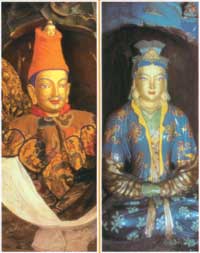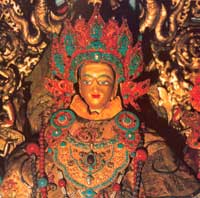| Plus |
|
|||
| Solemn grandeur
Remote and difficult to access Tibet may be but the fame of its most enduring monument, the Potala Palace has transcended many boundaries. And when you visit this towering symbol of Buddhist Tibet, you soon realise why the Potala has such a hold on people's hearts. Perhaps it is because its history is so closely intertwined with Tibet's own, stretching back to the 7th century when King Songstan Gampo decided to build an edifice worthy of his bride, Princess Wencheng of the Tang dynasty. This was an era when friendly ties between the Tibetans and the Han Chinese had blossomed and the King chose a site atop what is known as the Red Mountain, overlooking the city. Perhaps it is also because so many of the sacred symbols of Tibetan Buddhism still repose within its walls. Today, visitors to Lhasa see glimpses of the Potala Palace sitting in solemn grandeur on the hillside as they drive through the city streets. And when you finally arrive at the foot of the hill, it is like embarking on a journey back in time. Ticket formalities completed, it is a fairly steep climb to the gates of the Red Palace, to enter through huge doors like in some medieval castle. The Potala is divided into two, the Red Palace and the White Palace, the Red being mainly devoted to its sacred relics while the White Palace served as the centre for secular activities. What we see today however, is not King Songtsan Gampo's creation for the White and Red Palaces are credited to the Fifth Dalai Lama who in the seventeenth century expanded the original structure, employing thousands of workmen and artisans. Walking through the Potala today, is somewhat of an overwhelming experience for its statues and relics seem richer and more ornate from one dimly-lit chamber to the next, some being filled, nay literally crammed with them. There are the tombs of several Dalai Lamas, each richly embellished with gold and precious stones.
The chapel of the Seventh Dalai Lama also merits mention for his tomb stands 9.36 metres high and contains 498 kg of gold with a statue in the lotus position and several shelves containing his religious writings. Through a maze of smaller chambers and low doorways you reach the Western Audience Hall, an impressive space of tall pillars where the throne of the Dalai Lama commands attention. On the walls are scenes from the life of the Fifth Dalai Lama, including a mural of his audience with the Chinese emperor Shunzhi in Beijing in 1652. Descriptions in English are given in each room to help the visitor though the presence of a Tibetan guide to enlighten you on various little details is recommended. The statues
of the Buddha, Bodhisattvas, Dalai Lamas in gold, silver and copper
some large, others small, all exquisitely carved, each has a fascinating
history to it. Some are ancient, others have been gifted to the
Potala by devotees. In the Dharma Cave which dates back to the seventh
century are statues of King Songtsan Gampo, Princess Wencheng, Princess
Tritsun, his Nepali wife and their chief ministers. Every visitor to Tibet probably stops by the Potala as well as scores of Tibetans and whatever their nationality, making offerings at these sacred shrines is a tradition. Placed in each room are glass boxes and these are stuffed with notes, US dollars, Chinese yuan, French francs, et al. It is said that it is not uncommon for devout Tibetan Buddhists to give their entire savings to the Potala. Like in all Tibetan monasteries, large bowls are positioned in each room, ablaze with candles, their fluttering flames glowing in the dim chambers with passing devotees pausing to replenish the butter that keeps the lamps burning. The winter residence of the Dalai Lamas, Potala Palace is 13 storeys high and 384 feet (117 metres) in height, so visitors have a fair bit of climbing to do, not just up the hill but up many steep wooden staircases inside. There are 999 rooms here, with the Red Tower making it a grand thousand. Thus it is somewhat a relief when you finally emerge at the windy rooftop where you can take in a panoramic view of Lhasa and see the Potala's golden roofs close up. Here too, modernity has crept in; a small souvenir shop sells postcards, booklets and trinkets as well as iced soft drinks and smiling lamas chat on their sleek cell phones and pose with tourists for pictures. Then it's time to move to the White Palace which houses the living quarters of the Dalai Lama and the chambers where they conducted the affairs of state. In the top storey are the quaintly named West Chamber of Sunshine and the East Chamber of Sunshine and beneath the latter is the hall where the Dalai Lamas were traditionally enthroned. The Potala Palace was declared a UNESCO World Heritage Site in 1994 and though the 14th Dalai Lama remains in exile, the Chinese government has spent millions to preserve its treasures. Since the 1980s, some 200 million yuan has been spent on restoration of the Potala and other major monasteries in Tibet. And so we descend, down numerous steps and then out of the palace, past desolate buildings where once the Dalai Lama's vast retinue would have lived. There is this urge to turn back ever so often to take another look at the Potala and try hard to imprint this unique symbol of Tibet in our memories. |
||||
Copyright © 2001 Wijeya Newspapers
Ltd. All rights reserved. |

